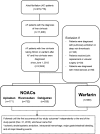Effectiveness and Safety of Non-Vitamin K Antagonist Oral Anticoagulant and Warfarin in Cirrhotic Patients With Nonvalvular Atrial Fibrillation
- PMID: 30834802
- PMCID: PMC6474939
- DOI: 10.1161/JAHA.118.011112
Effectiveness and Safety of Non-Vitamin K Antagonist Oral Anticoagulant and Warfarin in Cirrhotic Patients With Nonvalvular Atrial Fibrillation
Abstract
Background Liver cirrhotic patients with nonvalvular atrial fibrillation have been excluded from randomized clinical studies regarding oral anticoagulants for stroke prevention. Whether non-vitamin K antagonist oral anticoagulants ( NOAC s) are superior to warfarin for these patients remains unclear. Methods and Results This nationwide retrospective cohort study, with data collected from the Taiwan National Health Insurance Research Database, enrolled 2428 liver cirrhotic patients with nonvalvular atrial fibrillation taking apixaban (n=171), dabigatran (n=535), rivaroxaban (n=732), or warfarin (n=990) from June 1, 2012, to December 31, 2016. We used propensity score-based stabilized weights to balance covariates across study groups. Patients were followed until the occurrence of an event or the end date of study. The NOAC group (n=1438) showed risk of ischemic stroke/systemic embolism and intracranial hemorrhage comparable to that of the warfarin group (n=990) after adjustment. The NOAC group showed significantly lower risk of gastrointestinal bleeding (hazard ratio: 0.51 [95% CI, 0.32-0.79]; P=0.0030) and all major bleeding (hazard ratio: 0.51 [95% CI, 0.32-0.74]; P=0.0003) compared with warfarin group. Overall, 90% (n=1290) of patients were taking a low-dose NOAC (apixaban 2.5 mg twice daily, rivaroxaban 10-15 mg daily, or dabigatran 110 mg twice daily). The subgroup analysis indicated that both dabigatran and rivaroxaban showed lower risk of all major bleeding than warfarin. The advantage of lower gastrointestinal and all major bleeding with NOACs over warfarin is contributed by those subgroups with either nonalcoholic or nonadvanced liver cirrhosis. Conclusions NOACs have a risk of thromboembolism comparable to that of warfarin and a lower risk of major bleeding among liver cirrhotic Asian patients with nonvalvular atrial fibrillation. Consequently, thromboprophylaxis with low-dose NOAC s may be considered for such patients.
Keywords: atrial fibrillation; direct thrombin inhibitor; factor Xa inhibitor; hemorrhage; ischemic stroke; liver cirrhosis; mortality; warfarin.
Figures





Comment in
-
Anticoagulation for Atrial Fibrillation in Cirrhosis of the Liver: Are Low-Dose Non-Vitamin K Oral Anticoagulants a Reasonable Alternative to Warfarin?J Am Heart Assoc. 2019 Mar 5;8(5):e012102. doi: 10.1161/JAHA.119.012102. J Am Heart Assoc. 2019. PMID: 30834801 Free PMC article.
Similar articles
-
Efficacy and Safety of Apixaban, Dabigatran, Rivaroxaban, and Warfarin in Asians With Nonvalvular Atrial Fibrillation.J Am Heart Assoc. 2018 Apr 5;7(8):e008150. doi: 10.1161/JAHA.117.008150. J Am Heart Assoc. 2018. PMID: 29622587 Free PMC article.
-
Effectiveness and Safety of Apixaban, Dabigatran, and Rivaroxaban Versus Warfarin in Patients With Nonvalvular Atrial Fibrillation and Previous Stroke or Transient Ischemic Attack.Stroke. 2017 Aug;48(8):2142-2149. doi: 10.1161/STROKEAHA.117.017474. Epub 2017 Jun 27. Stroke. 2017. PMID: 28655814
-
Effectiveness and Safety of Dabigatran, Rivaroxaban, and Apixaban Versus Warfarin in Nonvalvular Atrial Fibrillation.J Am Heart Assoc. 2016 Jun 13;5(6):e003725. doi: 10.1161/JAHA.116.003725. J Am Heart Assoc. 2016. PMID: 27412905 Free PMC article.
-
Direct comparative effectiveness and safety between non-vitamin K antagonist oral anticoagulants for stroke prevention in nonvalvular atrial fibrillation: a systematic review and meta-analysis of observational studies.Eur J Epidemiol. 2019 Feb;34(2):173-190. doi: 10.1007/s10654-018-0415-7. Epub 2018 Jun 8. Eur J Epidemiol. 2019. PMID: 29948370
-
Non-Vitamin K Antagonist Oral Anticoagulants in Secondary Stroke Prevention in Atrial Fibrillation Patients: An Updated Analysis by Adding Observational Studies.Cardiovasc Drugs Ther. 2020 Aug;34(4):569-578. doi: 10.1007/s10557-020-06961-7. Cardiovasc Drugs Ther. 2020. PMID: 32297024
Cited by
-
Real-world use of nonvitamin K antagonist oral anticoagulant in atrial fibrillation patients with liver disease: A meta-analysis.Clin Cardiol. 2020 Jul;43(7):676-683. doi: 10.1002/clc.23408. Epub 2020 Jun 17. Clin Cardiol. 2020. PMID: 32557677 Free PMC article. Review.
-
Fatal Nonvariceal Gastrointestinal Bleeding in a Cirrhotic Patient Taking Apixaban with No History of Hemorrhage.Cureus. 2019 Nov 11;11(11):e6126. doi: 10.7759/cureus.6126. Cureus. 2019. PMID: 31886064 Free PMC article.
-
Safety of direct oral anticoagulants in patients with advanced liver disease.Liver Int. 2021 Sep;41(9):2159-2170. doi: 10.1111/liv.14992. Epub 2021 Jul 10. Liver Int. 2021. PMID: 34152697 Free PMC article.
-
Factor Xa inhibitors versus warfarin in patients with non-valvular atrial fibrillation and diabetes mellitus: a systematic review and meta-analysis of randomized controlled trials.Ann Med Surg (Lond). 2024 Jan 3;86(2):986-993. doi: 10.1097/MS9.0000000000001621. eCollection 2024 Feb. Ann Med Surg (Lond). 2024. PMID: 38333250 Free PMC article. Review.
-
Comparative Efficacy and Safety of Direct Oral Anticoagulants Versus Warfarin in Atrial Fibrillation Patients with Chronic Liver Disease: A Systematic Review and Meta-analysis.J Innov Card Rhythm Manag. 2024 Oct 15;15(10):6052-6061. doi: 10.19102/icrm.2024.15103. eCollection 2024 Oct. J Innov Card Rhythm Manag. 2024. PMID: 39502439 Free PMC article. Review.
References
-
- Tripodi A, Primignani M, Chantarangkul V, Dell'Era A, Clerici M, de Franchis R, Colombo M, Mannucci PM. An imbalance of pro‐ vs anti‐coagulation factors in plasma from patients with cirrhosis. Gastroenterology. 2009;137:2105–2111. - PubMed
-
- Northup PG. Hypercoagulation in liver disease. Clin Liver Dis. 2009;13:109–116. - PubMed
-
- Tripodi A, Mannucci PM. The coagulopathy of chronic liver disease. N Engl J Med. 2011;365:147–156. - PubMed
-
- Lin HJ, Wolf PA, Kelly‐Hayes M, Beiser AS, Kase CS, Benjamin EJ, D'Agostino RB. Stroke severity in atrial fibrillation. The Framingham Study. Stroke. 1996;27:1760–1764. - PubMed
Publication types
MeSH terms
Substances
LinkOut - more resources
Full Text Sources
Medical

